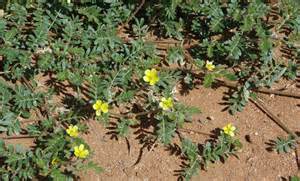Also known as Bindi, Doublegee or Bindy Eye, Caltrop is a mat forming annual weed that germinates in late spring through to early summer. A nuisance weed, Caltrop is frequently found in wasteland, pastoral land, cropping, vineyards and recreation areas where the spiky nutlets attach themselves to animal fur, clothing and shoes, or in the hooves of passing livestock. The nutlets of Caltrop also cause injury to bare feet on playing fields and parks.
Caltrop is also toxic to grazing livestock, especially sheep and by consuming the weed sheep can develop nitrate poisoning, photosensitisation and sheep staggers. One single Caltrop plant is capable of covering a large area and can discourage the growth of native flora, therefore effective weed identification and eradication is essential in pasture areas to prevent grazing animals becoming sick after eating Caltrop.
Caltrop stems can be up to 1 m long and spread radially from a central crown with a deep and woody taproot. The stems have many branches and are green or reddish-brown and leaves and stems have a silvery appearance because of the presence of hairs, particularly on the lower surface of the leaflets.
Producing bright yellow flowers from 5-15 mm in diameter, Caltrop flowers open in the morning and have 5 petals, each 4-12 mm long, which are quickly lost. The fruits of the weed are circular and flat, 8-12 mm wide and up to 8 mm high. Once the weed has reached maturity, they break into around 5 wedge-shaped woody nutlets.
Each nutlet has short spines all over the exposed surface, a pair of diverging 3-8 mm long spines about the middle of the outer surface and a pair of shorter downward pointing spines on the outer base. These nutlets can become attached to animals and people, causing them to be carried great distances where new infestations occur.
The key to controlling Caltrop is by limiting the amount of nutlets the plant produces. As infestations can become dense and mat-like, using a prickle roller or foam mat to pick up any nutlets from the ground will help reduce the amount of new plants emerging in the area. Using a suitable herbicide and reliable spot sprayers, target the plants for spraying in the early stages of germination which occurs in late spring. Spray all visible foliage thoroughly and check after seven days for any regrowth and apply a repeat treatment if necessary.
For further information on effective spray equipment to eradicate Caltrop, click here or call 1800 011 000 to speak to a member of the Rapid Spray team.



